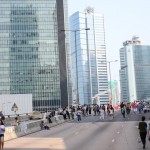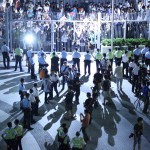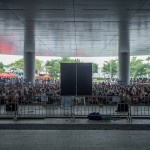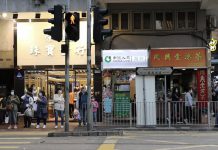Reimagining the use of public space after Occupy Hong Kong
By Julian Ng & Brian Yu
Today, traffic moves unimpeded on Harcourt Road in Admiralty and pedestrians must use footbridges to cross this important transport artery on Hong Kong Island. But four months ago, this same section of road was crowded with tents and countless banners were hung from the footbridges.
During the 79 days of the Occupy Movement, people’s eyes were opened to the possibility of a city where pedestrians, rather than cars, inhabited the roads.
In what became known as Harcourt Village, volunteers distributed free meals and citizens expressed their views on Hong Kong democracy by making speeches or music and artistic works

Surrounded by skyscrapers, Hongkongers would never have thought of walking on Harcourt Road, let alone interacting with strangers in a “self-organised” village. “Tim Mei Workshop”, a group of carpenters who wanted to remain anonymous, built wooden stairs with handrails so people could get over the concrete highway dividers. With the help of other participants, they even managed to set up an outdoor study room with furniture and electricity. A sense of community was gradually formed in the occupied area.
Emily Wong Lai-ming, a 40-year-old animator who initiated farming outside the Legislative Council Complex during the occupation, regards Harcourt Village as an example of a new concept of public space that calls for “mutual understanding, respect and ongoing communication.” Wong says: “This is how we can make a public space more well-used and meaningful.”
As a way to deepen her engagement with the movement, Wong started planting crops on the corner of Tim Mei Avenue and Harcourt Road. “I think the significance of farming in such public space is the connection,” says Wong, who adds connections are not just made through words but by actions that form examples that others can follow.
Wong’s action contributed to a new perception towards public space in Hong Kong. Others found different ways to link themselves to the movement. Activities like movie screenings, music performances and lectures were organised, homemade food was distributed, various local artists made handicrafts such as leather yellow ribbons and origami umbrellas as souvenirs.
Witnessing the spontaneity of the movement, Cole Roskam, an assistant professor in the Department of Architecture at the University of Hong Kong, was fascinated by how people interacted with each other in this small community.
“The public realm in Hong Kong is much more than simply physical space. The complex social activities that happen in these places are also part of it,” he suggests, “and what we do within those places is part of public space too.”
Roskam says public spaces in Hong Kong tend to be overly designed and very programmed as there are lots of regulations on how they are used. Public areas like parks are divided into different sections with particular restrictions such as forbidding ball games, bicycling and kite-flying.
But while people can only enjoy limited activities in common public space, the protesters in the occupied areas seemed to fully engage and utilise the spaces.
These observations motivated Roskam to hold a public forum in January, bringing in professional architects and some Occupy participants to broaden the discussion on how architects and design shape public space, and how the new kinds of activities challenge ideas of public space.
Roskam says the movement created opportunities for activities that take root in open spaces. He cites “Stand By You: Add Oil Machine”, which projected messages of support for the Umbrella Movement from around the world onto the Central Government Office (CGO) building. “Projecting social media messages on the building was a kind of very aggressive but interesting way of engaging with the government headquarters,” he says. “I found the resonances with some artistic and architectural projects very interesting.”
Rocco Yim, the designer of the government complex and the Tamar Project, was one of the speakers in Roskam’s public forum. Yim said his project was intended to create an open space for public engagement, and Tamar was designed to accommodate public gatherings, including protests. His “door always open” design for the complex symbolises openness.
Yim told the Wall Street Journal he was disappointed to see the construction of a three-metre high fence at the East Wing Forecourt of the CGO, and hoped it would not be permanent.
The East Wing Forecourt of the CGO became known as “Civic Square” during the Anti-National Education movement in 2012. Since then, it has been at the heart of different large-scale protests and many people look upon it as an open space for public gatherings.
However, in July last year, the Administration Wing of the Chief Secretary for Administration’s Office suddenly closed the East Wing Forecourt and erected a perimeter fence. It later reopened but with new restrictions barring the public from the area between 11 p.m. and 6 a.m., and only allowing protests to be held there on public holidays and Sundays with consent from the CGO management.

The space became the centre of attention once more on the evening of September 26 last year. As a week-long class boycott to demand open elections for the Chief Executive in 2017 drew to a close, more than a hundred demonstrators broke through the fence to “reclaim Civic Square” as a public space and show their support for democracy.
Among them was Jasmine Choi Yan-yan, a 22-year-old student of the Chinese University of Hong Kong, who was arrested on September 27. Choi says she had never intended to charge into the square – which led to the premature launch of the Occupy Movement – but she has no regrets. “[It was] originally a space that belongs to us,” she says.
Choi thinks people have the right to demonstrate in public spaces and that Civic Square should be accessible to citizens. “It is ridiculous that we need to get permission to assemble from the government that we are protesting against! Will the authoritarian government eventually prohibit us from protesting?” she says.
Choi thinks it is not only people’s rights in public spaces that have been undermined, but also their rights to assembly, which are determined by the Public Order Ordinance.
The current version of the Public Order Ordinance came into effect after the handover in 1997. It grants the government the authority to prohibit public assembly on a number of grounds, including national security and public order. Under the ordinance, citizens have to apply for a notice of no objection from the Commissioner of Police before more than 30 people can assemble in a public space.
The vice-chairman of the League of Social Democrats, Raphael Wong Ho-ming, also sees the Public Order Ordinance as a major impediment to Hongkongers trying to exercise their rights. “It requires you to apply for an approval from the police in any kind of protest,” he points out, “so even if you have public spaces, your right of protest is still constrained.”
Wong suggests that the ordinance should remove the requirement to apply for a no-objection notice a week in advance, and that communication between the government and the public should be free from restrictions. “How can you express your ideas with lots of metal and barricades in the area?” he questions.
Wong was charged, along with 77 others, with Forcible Entry and Unlawful Assembly under the Public Order Ordinance after breaking into Civic Square. He argues the charge cannot stand as Civic Square is a public area. What is more, he says the Administration Wing has violated their previous written undertaking that “when the works on the perimeter fence are completed, members of the public visiting CGO or the Legislative Council daily will not be affected and they will still have access to the East Wing Forecourt as usual”.
Access to the square is currently the subject of an application for a judicial review launched by Cheung Tak-wing, a photojournalist who was also arrested on September 27 in Civic Square
Representing Cheung, the Democratic Party’s Albert Ho Chun-yan argues Civic Square has long been a platform for the government and the public to communicate. “In the past three years, the officials always received petitions from the public in that area, and people are used to assembling and protesting there,” he stresses, “so the expectation of it being a public space is not coming from nowhere.”
Ho says the application has been accepted and he has invited senior counsel Gladys Li to take charge of the forthcoming legal procedure.
While the arguments over the definition of public space and the status of Civic Square continue, the Town Planning Board stated in documents from 2013 that: “The site in front of the G/IC (4) sub-area, being the East Wing Forecourt of the CGO, is an open-air civic square and public open space. It provides a popular gathering ground for civic functions and general recreational activities.”Yet, Carrie Lam Cheng Yuet-ngor, the Chief Secretary for Administration, says the forecourt is not part of the public open space mentioned in the planning permission, but simply an open area used as a vehicular access for the CGO. Lam says it is a government property and the decision to erect the fences was made to enhance security around the CGO.
Yet, Carrie Lam Cheng Yuet-ngor, the Chief Secretary for Administration, says the forecourt is not part of the public open space mentioned in the planning permission, but simply an open area used as a vehicular access for the CGO. Lam says it is a government property and the decision to erect the fences was made to enhance security around the CGO.
For Tam Yiu-chung, the chairman of the Democratic Alliance for the Betterment and Progress of Hong Kong, whether or not the square is a bona fide public space is a secondary concern. He regards occupying public space, as protesters did on September 26, as a misuse of rights and freedom. Tam agrees with the closing of the forecourt as a measure for maintaining public order.
“The two glass doors of the CGO were broken during the confrontation between the protesters and the police. This shows that the protesters can be quite radical and therefore regulation is needed for security reasons,” he says.

Alan Leong Kah-kit, the leader of the Civic Party, disagrees. He believes the current ordinance fails to grant people enough human rights and freedom. “I really think Hong Kong people deserve to be respected more given what we have amply demonstrated as a bunch of civilised intellectuals who definitely would be behaving ourselves when we are exercising our rights and freedom of assembly and demonstration,” he says.
Leong is also unconvinced by the Administration Wing’s stated security concerns. “If you are truly a Chief Executive of the people, for the people, by the people, why should you be afraid?” he says. “Because they do not want to come face to face with the people and this is a clear piece of evidence that we are moving towards of an authoritarian regime.”
Leong suggests public space can be used as a platform for communication between the public and the government.
Without enough existing public spaces for people to express their opinions, Leong thinks Harcourt Village provided an unprecedented experience for Hongkongers. His vivid recollections of holding meetings with his colleagues and sitting on Garden Road during the movement have made him reflect on the idea of public space and its uses.
“That experience I hope will result in more Hong Kong people embracing the idea that we should actually make available more public space for Hong Kong people to interact, for them to enjoy, and for them to put their creative minds to work,” he says.
Edited By Vivian Lai












































[…] The 79 days of the Occupy Movement opened Hongkongers eyes to the possibility of busy urban streets … […]
[…] http://varsity.com.cuhk.edu.hk/index…-public-space/ […]